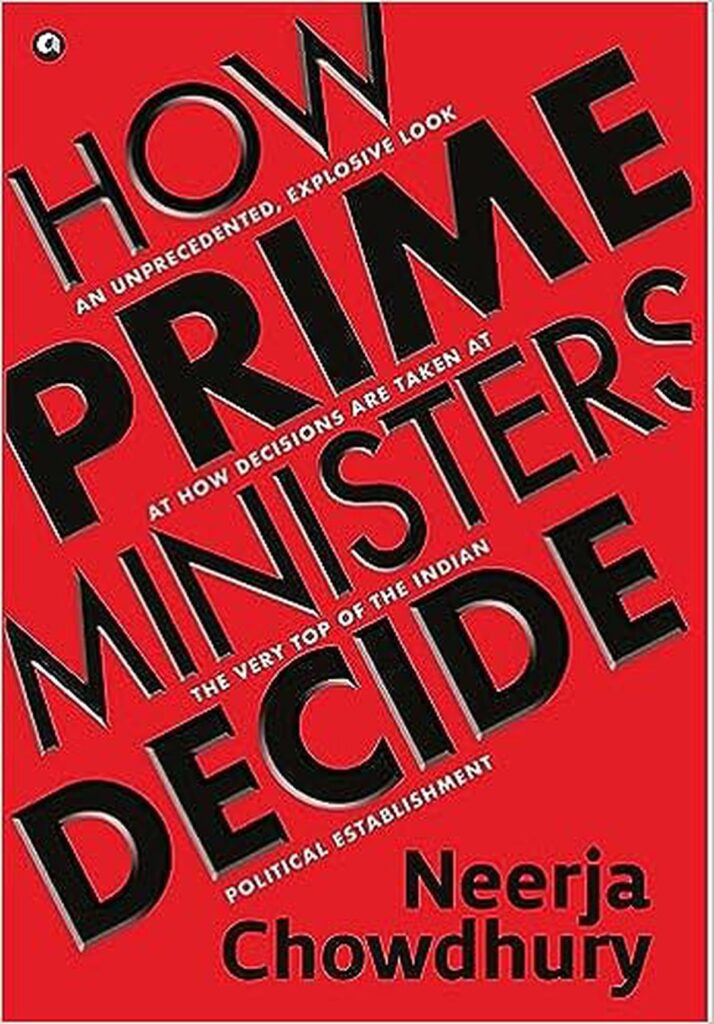About
Author: Neerja Chowdhury (India)
Genre: Political
Setting
Place: India
Time: 1960s-2020s
My Rating (see what this means)
My Subjective Rating: 3
My ‘Objective’ Rating: 2.63
Introduction

In her book, ‘How Prime Ministers Decide?’, veteran journalist Neerja Chou\wdhury explores, well, the question in the title – by closely following the journey of six prime ministers of India and trying to breakdown 6 consequential decisions each of them took during their tenures.
The questions themselves make the book interesting as they cover key milestones in India’s political history –
- Why did Indira Gandhi impose the emergency and what led her to call back elections?
- How did the progressive Rajiv Gandhi come to communalize Indian polity?
- What led to V.P. Singh‘s Mandal gambit which fundamentally altered political power structures?
- What Narasimha Rao did and did not do to prevent the demolition of the Babri Masjid?
- Why did Atal Bihari Vajpayee decide to take India nuclear?
- How did Manmohan Singh reverse decades of Indian ambivalence to the USA?
Through her own observations in her decades long journalistic career and other first-hand accounts – she makes a very readable book for anyone interested in Indian politics
Review
The answer to the title question in the book rests of a few key pillars – a treasure trove of first-hand accounts from tens of persons privy to the events, an exhaustive look at tenures of all but one long serving prime minister as well as the author’s own personal observations and notes.
All these make the book very comprehensive, broadly reliable and exhaustive. The rich trove of interesting anecdotes keep it a very engaging read throughout. The question itself is fairly pertinent and her conclusion seems reasonable.
However, a few minor shortcomings I found during the reading
- The book would require some pre-existing knowledge of Indian politics
- The structure of individual chapters wasn’t always intuitive – and while the story can be deciphered sufficiently clearly, it isn’t impossible to get bogged down in anecdotal entertainment
- The lack of a hypothesis-driven approach leads the answer to the central question receiving a less than adequate space. It isn’t subject it to exception testing either (details below)
<Spoilers below>
The writer does answer the central question – ‘How Prime Ministers Decide?’ fairly clearly –
“…decision-making was ad hoc, in-the-moment irrespective of who the prime minister was or the party to which s/he belonged. Most of the decisions, which were to impact millions were taken not with a fifty – twenty – or even a ten – year perspective. They were made largely with an eye on the immediate: firefighting, responding to a crisis, political exigencies. The goal: to resolve an issue, to come back to power, or to stay in power. If the decisions were usually determined by the need for political survival, the way in which they were taken — influenced by powerful lobbies, characterized by all manner of machinations and deceit, colliding ambitions and cut – throat competition — made for nail – biting suspense and drama.
There are sufficient examples in the book to build a strong case for writers conclusion. However, the final example – wherein Manmohan Singh pushed through a Indo-US civil nuclear deal to me felt like a contradiction. The push was more due to ideological commitment – even if it came with a risk to political power. That doesn’t invalidate Neerja’s central argument – which despite this remains valid. However, the gap in the argument is the ray of hope one needs – that politics need not be always cynical.
Picture Credits:
- Cover Picture: https://www.thehindu.com/lit-for-life/delhi-politics-india-prime-ministers-government/article67183272.ece